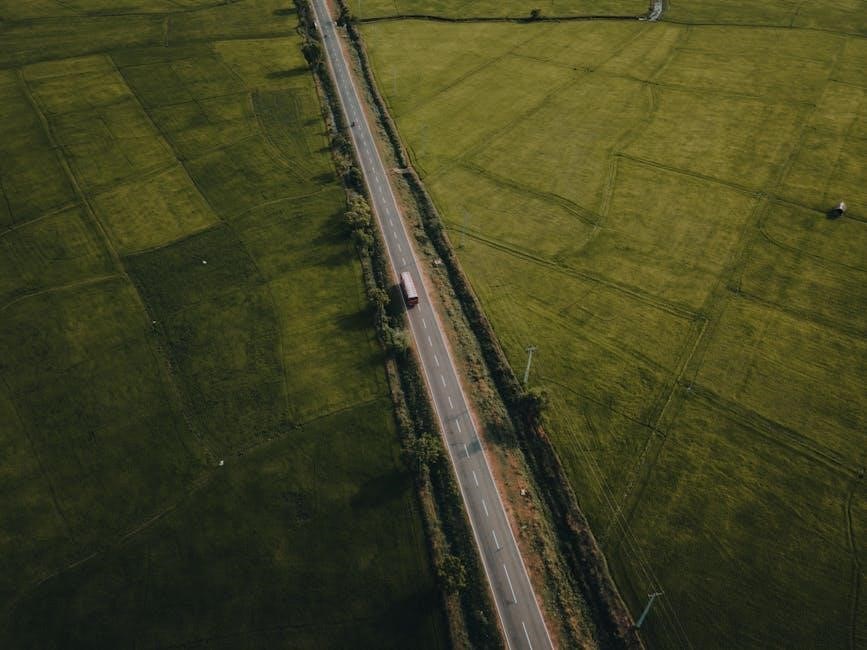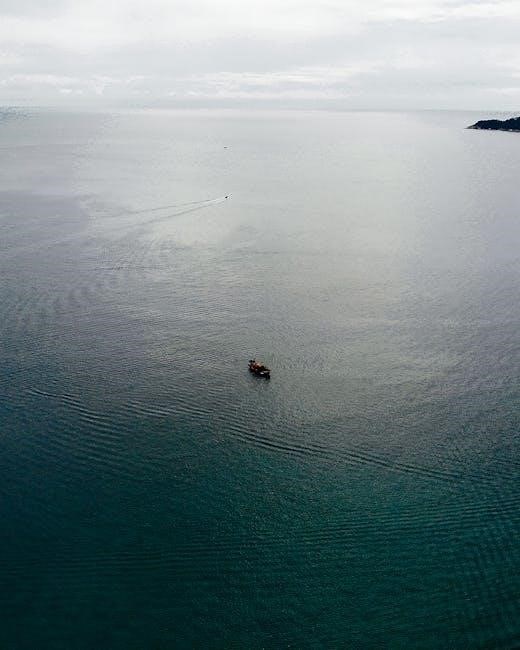Welcome to the Voyage Drone Instructions guide! This manual provides a comprehensive overview of the Voyage Aeronautics VA-1000 drone, including its features, setup, and operation. Designed for both beginners and experienced pilots, this guide ensures safe and enjoyable flights, covering essential topics like safety precautions, assembly, battery installation, and advanced flying techniques. Get ready to explore the skies with ease and confidence!
Overview of the Voyage Drone and Its Features
The Voyage Aeronautics VA-1000 drone is a compact, foldable micro-drone designed for versatility and ease of use. It features a high-definition camera capable of capturing 1280×720 resolution video and photos, making it ideal for aerial photography. The drone supports live video streaming directly to your smartphone via an app, allowing real-time monitoring of your flights. With a 2.4G wireless remote controller, the VA-1000 offers reliable connectivity and precise control. Its lightweight and portable design, combined with foldable arms, makes it easy to transport. The drone also includes multiple speed settings, obstacle avoidance in Training Mode, and a user-friendly interface for both beginners and experienced pilots. These features ensure an engaging and smooth flying experience.

Safety Precautions and Guidelines
Always follow safety guidelines to ensure safe drone operation. Avoid flying in bad weather, near obstacles, or people. Keep the drone away from pets and children. Properly handle the battery and avoid overcharging. Ensure the drone is on a flat, stable surface during setup. Maintain a safe distance from others while flying. Never fly near airports or restricted areas. Follow local regulations and manufacturer instructions carefully to prevent accidents.
General Safety Instructions for Drone Operation
Always ensure a safe environment for drone operation. Choose open spaces away from obstacles, people, and pets. Maintain a clear line of sight with the drone at all times. Avoid flying near airports, power lines, or restricted areas. Never operate the drone under the influence of alcohol or drugs. Keep the drone at a safe altitude to prevent collisions with trees or buildings. Ensure proper battery installation and avoid overcharging. Follow local drone regulations and respect privacy laws. Keep children and pets away during operation. Familiarize yourself with emergency procedures, such as landing protocols. Regularly inspect the drone for damage before flight. Always prioritize safety to protect yourself and others while enjoying your Voyage Drone.
Flying in Adverse Weather Conditions
Avoid flying your Voyage Drone in rain, snow, or fog, as moisture can damage the electronics. Strong winds or turbulence can make control difficult, increasing the risk of crashes. Ensure visibility is clear to maintain a safe line of sight. Avoid flying in extreme temperatures, as this may affect battery performance. If flying in cold conditions, monitor battery life closely, as capacity may decrease. Always check weather forecasts before flight and avoid adverse conditions. If weather deteriorates during flight, land immediately in a safe location. Maintain a safe distance from obstacles and avoid flying near power lines or wet surfaces. Follow these guidelines to ensure safe and enjoyable flights.

Unpacking and Initial Setup
Carefully open the box and verify all components, including the drone, remote, battery, and charger. Inspect for damage and ensure everything is in working order.
Components Included in the Package
The Voyage Aeronautics VA-1000 package includes the drone, remote controller, rechargeable battery, charger, and an instruction manual. Additional accessories may comprise a USB SD card reader for the microSD card, a phone holder for connecting your smartphone, and necessary cables. Ensure all items are present and undamaged to guarantee a smooth setup and operation. Each component plays a crucial role in the drone’s functionality, from flight control to camera operation. Familiarize yourself with each part to maximize your flying experience and ensure all features work seamlessly together.
Inspecting the Drone for Damage
Before using your Voyage Aeronautics VA-1000 drone, carefully inspect it for any visible damage. Check the drone’s body for cracks, dents, or broken parts. Examine the propellers for bends, breaks, or wear. Ensure the battery is intact, with no signs of swelling or damage. Verify that the remote controller and its sticks are functioning properly. Review the instruction manual to confirm all components are included and undamaged. If any issues are found, contact customer support before proceeding. A thorough inspection ensures safe and optimal performance during your first flight. Always prioritize safety and functionality to avoid potential risks or malfunctions.
Assembly and Folding
To assemble your Voyage Drone, carefully unfold and extend its arms, ensuring they lock securely into place. Handle the drone gently to avoid damage. Always fold the arms back after use for compact storage. Follow the manual’s diagrams for proper assembly and folding techniques to maintain your drone’s structural integrity and ensure smooth operation during flights. This step is crucial for both durability and performance. Make sure all parts are aligned correctly before flying. Proper assembly ensures a safe and enjoyable experience. Always refer to the instructions for guidance. Avoid forcing any components during assembly or folding. Store the drone in a protective case when folded to prevent accidental damage. Regularly inspect the folding mechanisms for wear and tear. Lubricate moving parts if necessary to maintain smooth operation. By following these steps, you can extend the lifespan of your drone and ensure optimal performance. Always handle the drone with care to avoid accidental damage. Keep the folding mechanism clean and free from debris. If you notice any issues during assembly or folding, consult the troubleshooting section for solutions. Proper assembly and folding are essential for the drone’s functionality and longevity. Never skip this step before or after flights. Ensure all components are securely locked in place to prevent mid-flight malfunctions. Practice folding and unfolding the drone to become familiar with the process. This will help you assemble and disassemble the drone quickly and efficiently. Always store the drone in a dry, cool place when not in use to prevent moisture damage. Avoid exposing the drone to extreme temperatures during storage. Regular maintenance of the folding mechanism will ensure your drone remains in excellent condition. If you plan to travel with the drone, always fold it properly to protect it during transit. Use a high-quality travel case to safeguard your drone during trips. Never leave the drone assembled in extreme weather conditions, as this can cause damage to the electrical components. Always follow the manufacturer’s guidelines for assembly and folding to ensure warranty coverage. Proper assembly and folding techniques are vital for the drone’s performance and longevity. Take your time during this process to ensure everything is done correctly. Enjoy flying your Voyage Drone with confidence after proper assembly and folding! Always prioritize safety and durability by following the recommended assembly and folding procedures. Happy flying!
Step-by-Step Guide to Folding and Expanding the Drone
Begin by unfolding the Voyage Drone arms gently, ensuring they click securely into place. Flip the drone and carefully pull each arm outward until fully extended. Always handle the arms with care to avoid damage. After use, fold the arms back by pressing the release mechanism and tucking them into the body. Store the drone in a protective case when folded to prevent damage. Regularly inspect the folding mechanism for wear. Lubricate if necessary. Follow the manual’s diagrams for proper alignment. Proper folding ensures compact storage and protects the drone during transport. Always unfold the arms fully before flight for optimal stability. Store in a dry, cool place. Avoid forcing parts during assembly or folding. Ensure all components are securely locked before flying. Consult the manual for detailed diagrams, such as Diagram E, for clarity. Proper folding and expanding ensure the drone’s longevity and performance. Always handle with care!

Battery Installation and Charging
Insert the fully charged battery into the compartment, ensuring it fits correctly. Lock it securely with the provided locks. Charge the battery using the included charger, avoiding overcharging. Always monitor the charging process and disconnect immediately once fully charged to prevent overheating. Never leave the charging process unattended. Store the battery in a cool, dry place when not in use. Properly handle the battery to maintain its lifespan and ensure safe drone operation. Follow all safety guidelines provided in the manual for optimal performance and longevity of the battery.
Proper Battery Handling and Charging Procedures
Always handle the battery with care to ensure safety and longevity. Insert the battery into the compartment, ensuring it fits correctly and is securely locked. Use only the provided charger to avoid damage. Charge the battery in a cool, dry place, away from flammable materials. Monitor the charging process closely and disconnect immediately once fully charged. Avoid overcharging, as it can degrade the battery’s performance. Never leave the battery charging unattended. Store the battery in a protective case when not in use. Proper handling and charging practices are essential for maintaining the health and safety of your Voyage Drone’s battery.

Remote Controller Setup
Sync the remote controller with your Voyage Drone by placing it on a flat surface. Use the designated buttons to establish a stable connection for smooth flight control.
Syncing the Drone and Controller
To sync your Voyage Drone and controller, follow these steps: Ensure the drone is on a flat, level surface. Turn on the drone and the remote controller. Move the left throttle stick fully up and then back down; you’ll hear two beeps. The red LED light on the drone will stop flashing and remain solid, indicating successful synchronization. Once synced, you’re ready to begin your flight. Always ensure the area is clear and safe before proceeding. Proper synchronization is crucial for smooth and responsive control during flight operations. This process ensures optimal communication between the drone and its controller, enhancing your flying experience.

Pre-Flight Preparations
Before flying, ensure the drone and controller are fully synced. Check the propellers, battery level, and surroundings for safety. Calibrate the drone on a flat surface to ensure stability and accurate navigation during flight. Proper preparation is key to a smooth and enjoyable experience.
Choosing a Safe Location for Flight
Always select a safe and open area for flying your Voyage Drone, free from obstacles like trees, buildings, or power lines. Avoid flying near airports, crowded spaces, or sensitive areas. Ensure the location is windy conditions and clear of people or pets. Choose a flat, even surface for takeoff and landing to maintain stability. Verify local regulations and airspace restrictions before flying. Opt for areas with minimal interference from other devices. A large, open field is ideal for beginners to practice basic controls and maneuvers. Always prioritize safety and avoid flying in adverse weather conditions like heavy rain or strong winds. A safe location ensures a smooth and enjoyable flying experience.
Calibrating the Drone Before Flight
Calibration is crucial for ensuring the Voyage Drone operates smoothly and maintains stability during flight. Before calibration, place the drone on a flat, level surface and ensure the battery is fully charged. Remove the battery, turn off the controller, and restart the system. Once powered on, sync the drone and controller by pushing the left throttle stick up and down until you hear a beep. This process ensures the gyro sensors are balanced. Calibration is especially important after crashes or shocks, as it helps restore the drone’s equilibrium. Always calibrate in a stable environment, avoiding windy or uneven surfaces. Proper calibration guarantees precise control and a secure flying experience. Follow the manual for detailed steps to ensure accuracy.
First Flight Instructions
Start by ensuring the drone is on a flat, level surface. Use the auto-start feature by pressing the AUTO START/LAND button on the controller to begin your maiden flight.
Starting and Stopping the Rotors
To start the rotors, ensure the drone is on a flat, level surface. Press the AUTO START/LAND button on the controller to activate the auto-start feature; The rotors will spin and the drone will lift off automatically. For manual start, push the left throttle stick up until the rotors begin spinning. Always ensure the area is clear of obstacles before starting. To stop the rotors, press the AUTO START/LAND button again or gently lower the left throttle stick to the bottom position. The drone will descend and disarm automatically. Remember to keep the controller steady and avoid sudden movements during startup and shutdown for safe operation.

Basic Flight Controls
Master the Basic Flight Controls with the left throttle stick for altitude and rotation, and the right direction stick for forward, backward, left, and right movement. Practice in an open space to refine your skills.
Understanding Throttle and Direction Sticks
Mastering the throttle and direction sticks is essential for controlling your Voyage Drone. The left throttle stick regulates altitude and rotation. Moving it up increases propeller speed, making the drone ascend, while moving it down decreases speed, causing it to descend. Rotating the stick left or right makes the drone spin in the respective direction. The right direction stick controls forward, backward, and lateral movement. Pushing it up moves the drone forward, while pulling it down moves it backward. Moving the stick left or right makes the drone bank in those directions. Always start in an open space to practice these controls and ensure smooth, precise flight maneuvers.
Mastering Vertical Takeoffs and Landings
Mastering vertical takeoffs and landings is crucial for safe and efficient drone operation. The Voyage Drone features an auto-start/land function, activated by pressing the AUTO START/LAND button on the controller. For manual control, gently push the left throttle stick up to ascend and down to descend. Ensure the drone is on a flat, level surface and avoid obstacles. When landing, reduce altitude slowly and maintain steady control. Practice in a large, open area with minimal wind for better stability. Always keep the drone in your line of sight and avoid flying too low or near obstacles. Perfecting these maneuvers ensures smooth, incident-free flights and prolongs your drone’s lifespan.
Advanced Flying Techniques
Explore advanced features like speed settings (Training, Slow, Medium, High) and 360 stunt rolls. Utilize the obstacle avoidance feature in Training mode for smoother maneuvers and enhanced flight control.
Speed Settings and Training Mode
The Voyage Drone offers four speed settings: Training (T), Slow (1), Medium (2), and High (3). Training mode is ideal for beginners, limiting speed and height to prevent crashes. It includes obstacle avoidance, automatically steering clear of objects. Switch modes using the controller’s speed button, with beeps indicating the current setting. Training mode also restricts altitude, protecting from ceiling or floor collisions. This feature helps new pilots master controls and build confidence. Adjust speed settings before or during flight for a tailored experience. Training mode ensures a safe and gradual learning curve, making it perfect for practicing basic maneuvers in open spaces.
Performing 360 Stunt Rolls
To perform a 360 stunt roll with your Voyage Drone, press the dedicated stunt roll button on the controller. You’ll hear a beep, indicating the drone is ready. Once activated, the drone will execute a smooth, complete roll. For optimal results, ensure the drone is at a safe height and clear of obstacles. To exit stunt mode, press the button again, and the beeping will stop. This feature allows for exciting aerial maneuvers while maintaining control. Practice in open spaces to master the technique and enjoy the thrill of advanced flying with your Voyage Drone.

Camera Operation
The Voyage Drone features an HD camera, capturing stunning 1280×720 pixel videos and photos. Use the controller to toggle between photo and video modes effortlessly during flight.
Setting Up the HD Camera
To set up the HD camera on your Voyage Drone, ensure the microSD card is formatted and inserted properly. Connect the card to your computer using the provided USB reader, format it, and install it into the drone’s camera port. Power on the drone and controller, then test the camera by capturing a photo or recording a video using the controller’s camera button. The camera’s LED indicators will flash to confirm functionality. For optimal performance, ensure the camera lens is clean and free of obstructions. Always store the microSD card in a safe, dry location to protect your footage.
Taking Photos and Recording Videos
To capture stunning aerial footage, use the HD camera on your Voyage Drone. Press the CAMERA button on the remote controller to take photos—short press for a single shot. For videos, long-press the button for 2 seconds to start recording. The drone’s LED lights will flash, and you’ll hear beeps to confirm the action. Use the same button to stop recording. All media is saved to the microSD card. Ensure the card is properly formatted and installed before use. Regularly download your photos and videos to free up storage space and maintain optimal performance. Always store your media securely to preserve your aerial creations.
Formatting and Managing the microSD Card
Before using the microSD card in your Voyage Drone, format it by inserting it into the provided USB card reader and connecting it to your computer. Right-click the card icon, select format, and follow the prompts. Ensure the card is properly formatted to prevent errors. After formatting, install the card into the drone’s camera port. To manage your media, regularly transfer photos and videos to your computer and delete them from the card to free up space. Always handle the microSD card gently and store it in a clean, dry environment. Proper management ensures smooth camera operation and optimal storage for your aerial captures.
Drone Calibration
Your Voyage Drone comes pre-calibrated for optimal performance. If drifting occurs after crashes, recalibrate by pressing the calibration button on the controller and following the on-screen instructions.
Calibrating the Gyro Sensors
To ensure stable flight performance, calibrate the gyro sensors if the drone drifts or loses balance. Start by syncing the drone and controller on a flat surface; Press and hold the calibration button on the controller until the lights flash. Move the left throttle stick fully up and back down to complete the process. Avoid moving the drone during calibration. Once done, the drone will beep, indicating successful calibration. For optimal results, recalibrate after crashes or firmware updates. This ensures precise control and stability during flights. Regular calibration is essential for maintaining smooth and responsive drone operation.

Troubleshooting Common Issues
Resolve connectivity and flight stability problems by restarting the drone and controller. Ensure proper syncing and check for firmware updates. Address drift by recalibrating gyro sensors for optimal performance.
Resolving Connectivity and Flight Stability Problems
To address connectivity issues, ensure the drone and controller are properly synced. Power cycle both devices, then resync by pressing the sync button until the LED lights flash. If flight stability is compromised, check for firmware updates and recalibrate the gyro sensors. Place the drone on a flat, level surface and follow the calibration steps in the manual. For persistent drift, adjust the trim settings using the controller’s trim buttons. Ensure the propellers are securely attached and free from damage. If issues persist, reset the drone to factory settings or contact customer support for assistance. Regular maintenance ensures optimal performance and stability during flights.

Warranty and Support Information
Your Voyage Drone is covered by a limited warranty, ensuring defective parts are repaired or replaced within the warranty period. For inquiries or claims, contact Voyage Aeronautics Support via their official website or customer service email. Keep your purchase receipt and serial number handy for verification. Warranty terms vary by region, so refer to the enclosed warranty booklet for specific details and conditions.
Understanding the Warranty Terms
The Voyage Drone warranty provides coverage for manufacturing defects, ensuring your device is free from issues upon purchase. The warranty period typically lasts for one year, though this may vary depending on the region and specific product model. To claim warranty benefits, you must provide proof of purchase, such as a receipt or order confirmation. Damages caused by misuse, accidents, or unauthorized modifications are not covered. For detailed terms, refer to the warranty booklet included with your drone. Contact Voyage Aeronautics Support for inquiries or assistance with warranty claims. Always retain your drone’s serial number and purchase documentation for verification purposes.
